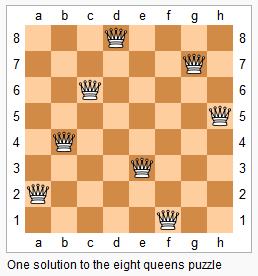N-Queens
The n-queens puzzle is the problem of placing n queens on an n×n chessboard such that no two queens attack each other.

Given an integer n, return all distinct solutions to the n-queens puzzle.
Each solution contains a distinct board configuration of the n-queens’ placement, where ‘Q’ and ‘.’ both indicate a queen and an empty space respectively.
Example:
Input: 4
Output: [
[".Q..", // Solution 1
"...Q",
"Q...",
"..Q."],
["..Q.", // Solution 2
"Q...",
"...Q",
".Q.."]
]
Explanation: There exist two distinct solutions to the 4-queens puzzle as shown above.
历史渊源(wikipedia)
八皇后问题最早是由西洋棋棋手马克斯·贝瑟尔(Max Bezzel)于1848年提出。第一个解在1850年由弗朗兹·诺克(Franz Nauck)给出。并且将其推广为更一般的n皇后摆放问题。诺克也是首先将问题推广到更一般的n皇后摆放问题的人之一。
在此之后,陆续有数学家对其进行研究,其中包括高斯和康托,1874年,S.冈德尔提出了一个通过行列式来求解的方法,这个方法后来又被J.W.L.格莱舍加以改进。
1972年,艾兹格·迪杰斯特拉用这个问题为例来说明他所谓结构化编程的能力。他对深度优先搜索回溯算法有着非常详尽的描述。
解题
def solveNQueens(self, n):
res = []
self.dfs([-1]*n, 0, [], res)
return res
# nums 是一个一维度数组,[1, 3, 0, 2] 意思是第一个 queen 放在第一列,第二个 queen 放在第三列,以此类推
def dfs(self, nums, index, path, res):
if index == len(nums):
res.append(path)
return # 回溯
for i in xrange(len(nums)):
nums[index] = i
if self.valid(nums, index): # pruning
tmp = "."*len(nums)
self.dfs(nums, index+1, path+[tmp[:i]+"Q"+tmp[i+1:]], res)
# 第 n 个 quuen 是否能被放在当前列
def valid(self, nums, n):
for i in xrange(n):
if abs(nums[i]-nums[n]) == n -i or nums[i] == nums[n]:
return False
return True
还是有些地方不能理解,需要回头再仔细琢磨下。
conlusion
最近状态有些低迷,又开始了懒惰,还有些迷茫,不知道坚持下去的意义是什么,明天继续努力吧。
自律是自由的前提,这世上没有绝对的自由。